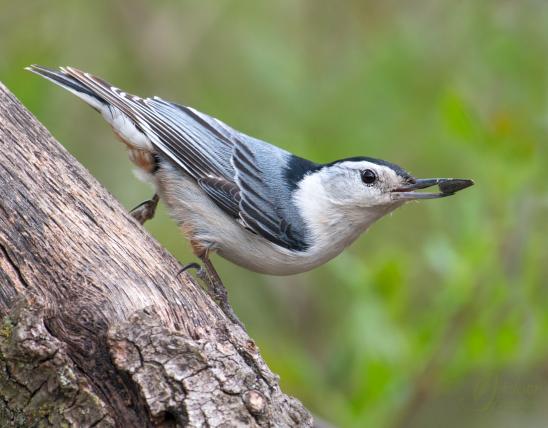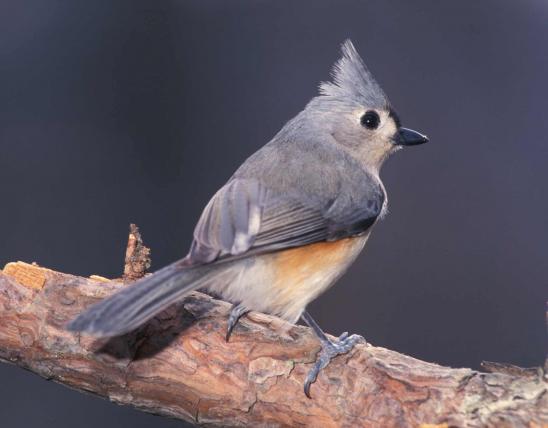
The brown-headed nuthatch is a small, stocky bird with a brown cap; its squeaky call sounds a lot like a rubber ducky. Like the more common white-breasted nuthatch, it creeps and climbs around on trunks and branches upside-down, right-side up, and sideways with equal ease.
Adult upperparts are bluish gray, with brown on the top of the head. The bottom margin of the brown cap, where it crosses through the eye, is usually darker. Adult underparts are dull whitish. The song is a high-pitched, two-note squeaka! squeaka! squeaka!, which sounds like a rubber ducky or a doggie squeak toy. In flocks, they also can make a rapid series of various jumbled, chittery squeaks; these might be confused with the voice of hummingbirds, but they don’t sound like our other nuthatches.
Similar species:
- The white-breasted nuthatch occurs statewide and is much more common. It is larger and has a black forehead crown and nape (no brown cap); females have a gray cap. Flanks are buffy. Song is low-pitched and nasal: “yank-yank-yank.”
- The red-breasted nuthatch is an uncommon winter resident in pine forests; it has rusty underparts and has a bold white stripe above the black eye line. Song is higher-pitched than the white-breasted nuthatch’s but is also nasal: “wak, wak, wak, wak, wak.”
- The black-and-white warbler also creeps upside-down on trees, but it is distinctly striped with black and white and has the body shape of a warbler.
- The brown creeper also creeps around on tree trunks, but its upperparts are mottled brown, visually blending with tree bark. Its tail is stiff like a woodpecker’s, helping to prop the creeper as it climbs. It usually doesn’t climb upside-down.
Length: 4½ inches.
Reintroduced to suitable pine-woodland habitats in the Mark Twain National Forest in southern Missouri.
Habitat and Conservation
Look for brown-headed nuthatches in mature pine woodlands with an open understory. In Missouri, they have been reintroduced to restored pine habitats in the Mark Twain National Forest in the southern part of the state. Listen for the telltale, squeaky calls. You will probably hear them first. Then, if you’re lucky enough to see them, they will probably be high in the trees. They often forage in groups on tree branches and trunks, creeping up and down among the pine needles and bark, and sometimes flying from tree to tree.
Brown-headed nuthatches require healthy, stable pine-woodland habitat — something Missouri had mostly lost but has been gradually regaining. Now that our state has restored some of its pine woodlands, recent efforts to reintroduce the brown-headed nuthatch to Missouri have been successful. Our new populations of these tiny birds were trapped in the Ouachita Mountains of Arkansas, where the species has healthier numbers.
Until recently, the brown-headed nuthatch was considered extirpated from Missouri; the last records of their presence in our state date to the late 1800s and early 1900s, coinciding with the time that extensive logging removed nearly all of our state’s native shortleaf pine forests. In the following decades, as the former pinelands became wooded again, the landscapes were dominated by faster-growing oak and hickory trees and not by pines.
It has taken a concerted effort to restore pine woodland to Missouri, involving multiple agencies, carefully managed timber harvest, tree thinning, prescribed fire, and planting of native shortleaf pine and other plants common in shortleaf pine woodlands.
Food
Brown-headed nuthatches creep and climb along pine boughs and over cones, picking insects, spiders, and seeds from crevices. In winter, their principal food is the seeds of pine cones.
This is one of the few bird species to use tools. A brown-headed nuthatch will sometimes pick up a fragment of bark in its bill and use it to pry open bark to uncover insects. When they are foraging on pine seeds, they usually wedge the seed into a crevice of bark in order to peck it open.
Brown-headed nuthatches often are members of mixed-species flocks that forage together. One of the ways this strategy works is because the different species — including chickadees and titmice, for example — tend to look for different types of foods, or to forage in different parts of trees or woods. But when pine warblers are part of the same flock as brown-headed nuthatches, conflicts can occur. When the two forage within the same flock, the nuthatches forage mostly near the branch tips, while the pine warblers forage on the sections of the limbs closest to the trunk. When pine seeds are numerous, the nuthatches move toward the larger limbs and the trunk to crack the seeds, leading to conflicts with the pine warblers.
Status
A Missouri species of conservation concern.
Until recently, the brown-headed nuthatch was considered extirpated from Missouri. Reintroduction efforts, hinging on maintaining suitable habitat, have hopefully changed this status. The approximately 100 birds that were reintroduced in 2020 and 2021 are being monitored to see how well they survive. If this species is deemed a successful reintroduction, it will be considered a permanent resident (it is nonmigratory).
The brown-headed nuthatch’s overall range extends from Delaware to eastern Texas and Oklahoma, and from Tennessee and Arkansas to the Gulf Coast — that is, the southeastern pine forests. This species is highly vulnerable to the effects of climate change, since it will probably lose most or all of its pineland habitat and range.
Life Cycle
Brown-headed nuthatches excavate their own nesting cavities in dead, decaying trees using their stout, powerful, chisel-like bills. They may also use existing holes excavated by other nuthatches or woodpeckers, or they may use nest boxes. Clutches comprise 3–7 eggs, which are incubated by the female for about 2 weeks. Fledging occurs about 18 days after hatching. A brown-headed nuthatch can live to be at least 5 years old. There is usually only 1 brood per year.
Sometimes there is a “helper” male that assists the mated pair with nesting activities; this is usually a son from a previous season. The helper male assists with nest excavation, bringing food to the brooding female, and bringing food to young. Biologists posit that these males benefit by gaining experience and by helping their relatives to reproduce. This usually happens in years or situations where the young males would not be able to acquire or maintain nesting territory or reproduce successfully on their own.
Brown-headed nuthatches do not migrate, are relatively weak fliers, and don’t disperse great distances, which is one reason why birds were trapped in Arkansas and moved to Missouri: it was unlikely the Arkansas populations would recolonize the restored pine woodlands in the Ozarks, even though it was only a distance of about 200 miles.
Human Connections
The loss of Missouri’s brown-headed nuthatches didn’t occur overnight, and neither did their restoration. Both processes required determined, coordinated effort among many partners. In between, mountains of basic research needed to happen, in seemingly abstract areas: woodland ecology, the role of fire in maintaining native habitats, population dynamics (of forest trees and of birds), and the fine points of nuthatches’ life history. Also, during the decades that these nuthatches were absent from our state, enough people had come to the conclusion that nature was worth protecting. During the last century, the modern conservation movement was born and came to fruition, with bird conservation a popular and compelling component.
Ecosystem Connections
Until reintroduction efforts brought it back, the brown-headed nuthatch was extirpated from Missouri due to the lack of suitable pine savanna habitat. For the same reason, the red-cockaded woodpecker also disappeared from Missouri (that bright-white-cheeked woodpecker is now a federally endangered species), and the Bachman’s sparrow is endangered in our state. Meanwhile, the pine warbler — another bird whose main habitat is pine woodlands — is more tolerant of the oaks and other trees and shrubs growing among the pines, and it remains a common summer resident in appropriate regions in our state.
Woodlands are different from forests. Forests have a dense canopy that almost completely shades the forest floor, but in the various types of woodlands, some amount of sunlight passes through the canopy to reach the ground, allowing for a rich layer of grasses, forbs, and shrubs. These provide nesting habitat for a wide range of birds and other species. Other birds that require open wooded habitats for nesting include prairie warbler, yellow-breasted chat, red-headed woodpecker, and eastern whip-poor-will.
Historically, woodlands remained open because fires occasionally swept through, limiting shrubby undergrowth and invigorating groundcover plants such as grasses and forbs. As with the fires that historically maintained prairie and savannah habitats, these fires were set by Native Americans or by lightning. These habitat types lasted for thousands of years.




About 350 species of birds are likely to be seen in Missouri, though nearly 400 have been recorded within our borders. Most people know a bird when they see one — it has feathers, wings, and a bill. Birds are warm-blooded, and most species can fly. Many migrate hundreds or thousands of miles. Birds lay hard-shelled eggs (often in a nest), and the parents care for the young. Many communicate with songs and calls.



























